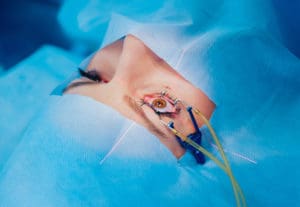PRK Recovery Time, Tips & What to Expect
Last Updated:
If you have a refractive error and for any number of reasons do not qualify for LASIK, you may be recommended for photorefractive keratectomy (PRK), a similar procedure to LASIK that can correct nearsightedness, farsightedness, or astigmatism. PRK is an older procedure, developed before LASIK. Because of how the overall surgery process works, it takes a little longer for patients to fully heal from PRK compared to LASIK. This means that you will need help getting home after this outpatient operation, and you may need to take a week to 10 days off work to allow your eye to heal. You will also get prescription eye drops that you must use for at least a month, and there will be several activities you should avoid for weeks or even months after the operation.
Table of Contents

This article contains information to help you learn more about PRK and how long the overall healing process takes. It is important to note that your eye surgeon will have much more detailed information for you. When you go to your follow-up exams, you will be able to learn more about how your eye is healing and how long the process is taking you, specifically.
What Is Photorefractive Keratectomy, and How Long is the Healing Process?
Photorefractive keratectomy (PRK) is a laser-assisted surgery used to correct refractive errors like nearsightedness, farsightedness, and astigmatism. While less famous than LASIK, PRK precedes LASIK by a few years. Although many ophthalmologists and eye surgeons still practice PRK and recommend it to several patients, it is less popular in large part because the recovery time is longer.
Having PRK as an option to improve visual acuity is important. The surgery is a great LASIK alternative for people who have thinner corneas because there is no blade or laser that makes a flap in the cornea. Instead, it shaves off some of the top corneal layer. It is also a great option for people who have physically active careers or lives and need to know they will not damage their eye in the months after the operation.
You deserve clear vision. We can help.
With 135+ locations and over 2.5 million procedures performed, our board-certified eye surgeons deliver results you can trust.
Your journey to better vision starts here.
If you are interested in PRK to correct your vision, it is important to understand how the surgery works, especially the recovery time, which takes longer than LASIK and some other laser-assisted procedures. While most people recover quickly, the timeline is more like weeks compared to the mere days of recovery from LASIK. If you follow your surgeon’s instructions for recovering from PRK, you can get great results from this procedure.
Timeline for PRK Surgery Recovery
- Before surgery: Follow your surgeon’s pre-surgery instructions, and plan to take about a week off work for your PRK surgery recovery. Although you will get some clarity back in your vision in the first day or so after PRK, you should not strain your eyes for several days, so that means little to no work on the computer, no driving, and little to no reading if possible.
- Right after surgery: Make sure you have someone you trust drive you home right after the procedure. Although you will have only local anesthetic, so you will not be groggy, you will not be able to see very well and will need help getting around safely. You should also plan to take a nap once you arrive home, or find a way to relax without using your eyes, so no television or reading. You will get medicated eye drops that will help your cornea heal, and if you have any discomfort, over-the-counter pain medications can be very helpful. It is unlikely you will receive prescription painkillers for this procedure because any serious pain that does not go away within a day or two, or that gets worse, needs to be reported to your eye doctor, as it is a sign of complications. You can take a shower the day after your surgery, but you may need to use a special shield on your eye to protect it from products like soap and shampoo. You will need to avoid anything that can get in your eye like lotion, hairspray, and makeup.
- Days 2 to 4 after surgery: You may still have some eye pain and discomfort during this time, but that is normal and should be relieved by over-the-counter painkillers. You will also continue wearing the bandage contact lens during this time, to protect your cornea as it grows back. During this period of time, you are most likely to experience side effects from the procedure.
- Watering eyes
- Sensitivity to light
- Some blurry vision
- A sense of burning or dryness
- Itching
- Feeling like a foreign object is constantly in your eye

The second and third days after PRK will be the most uncomfortable, but symptoms can be managed with rest and OTC painkillers. They will begin to go away by day four. If they do not go away within a week, or they get worse, contact your doctor.
You should avoid exercise during this time, partly because it can impact how your eye heals, but also because you want to avoid getting sweat in your eye. Even mild exercise can negatively impact your eye’s healing ability.
- Day 5 after surgery: This is likely the time when you will remove the bandage contact lens. Do not do this yourself. Your optometrist will do it for you at your follow-up appointment. The cornea will heal from the edges toward the center, which may create a small ridge of epithelial tissue across the pupil. Once the contact lens is removed, you may notice great improvement in your vision, depending on how serious your refractive error was before. Usually correction ranges between 20/30 and 20/50, so your vision may continue to improve over the next several weeks, but you will already have better visual acuity.
- Weeks 1 to 4 after surgery: You should be healed enough to go back to work after this time, and you should be able to drive safely again. If you experience any side effects that linger after the surgery that have not gone away within 7 to 10 days, you need to contact your eye doctor for help. Exceptions to this are some visual side effects like halos, glares, starbursts, or trouble seeing at night. If you are concerned about these effects, especially if they are getting worse, it is worth reporting them; however, a mild experience of these issues is common for the next week to month. During the first week of PRK surgery recovery at home, you will not be able to wear makeup or use face lotion or other products that may get in your eye. Wait more than a week after PRK if you want to get your hair colored or professionally styled. You should avoid strenuous or high-impact sports, like sprinting, soccer, football, or wrestling because this can damage your eye during the healing process. Additionally, for the first one to two weeks, avoid hot tubs, swimming, or any activity other than showering that might get water and other chemicals in your eye. Your doctor may also recommend that you avoid gardening, dusting, or related activities that may get small particles in your eye and affect your cornea’s healing process.
- Weeks 4 to 6 after surgery: Your vision will continue to improve gradually during this time. In the first month (four weeks), you will continue to use prescription eye drops to reduce the risk of corneal haze, a common side effect from PRK because of how the corneal tissue must heal. Your eye may continue to feel dry during this time, but most other side effects, including sensitivity to light and visual distortions, will be reduced.
- Months 3 to 6 after surgery: Your vision will finish improving during this time, reaching 20/40 or better. In fact, 9 out of 10 people who get PRK to improve their vision experience 20/40 vision or better within six months of the procedure.
- The 1-year mark: Although it is important to wear sunglasses to protect your eyes from ultraviolet radiation anyway, you may need to wear antiglare sunglasses on bright days for the first year after your surgery. You can speak more with your optometrist or ophthalmologist about this, but your lens may have difficulty focusing in very bright light. You may also find that you need to wear antiglare glasses for some activities, particularly if you work in a job that requires many hours in front of a computer screen.
Additional timeline information can be provided at each follow-up appointment, which your surgeon and optometrist will schedule with you. Be sure to go to each follow-up appointment so the progress of your eye’s healing can be closely monitored, and any complications can be addressed before they become serious.

What Can I Expect During and After PRK?
During PRK surgery, you will get a local anesthetic in the form of numbing eye drops, and you will be placed in a special device that will keep you from blinking during the short procedure. Some layers of cells will be removed from your cornea, using either a brush, blade, or an alcohol solution. Like LASIK, a laser that has been preprogrammed with specifications on how to reshape the lens of your eye will be guided to improve the refractive potential of this organ. You will be asked to look at a target while the laser works, so your eye does not move, although there are safety switches in laser devices that will turn the machine off in the event that you do move; this way, the risks to your eye are very low. The entire procedure takes between 5 and 15 minutes per eye, including overall setup for the surgery itself.
Once the surgery is complete, there are several clear steps to take that start with getting home. A special bandage contact lens will be put over your eye after surgery, and you may receive special sunglasses or an eye patch to protect your eye from excessive light. Your exact recovery time will vary a little, but the overall PRK surgery recovery process will be similar among many patients.
Most People Get Great Visual Acuity With PRK
In a long-term follow-up study after LASIK, PRK, and other refractive surgeries, 70.3 percent of respondents reported that they were very satisfied with their vision without corrective glasses or contact lenses. About 57 percent of respondents said that their vision was much better after surgery compared to prior even with corrective wear like contact lenses or glasses. The procedure did not negatively impact the majority of patients’ abilities to perform procedures or their work accurately; 24.2 percent reported that their work was much easier, 59.4 percent reported that it was about the same, and 1.6 percent reported that, due to some complications, their work was more difficult. No respondents reported that their work was impossible.
The most common side effects, both short-term and long-term, included eyes feeling irritated, sensitivity to light, some pain in the eyes, trouble judging distance going up or down stairs, and trouble with depth perception. Much of this related to healing and recovery time, and the issues could be adjusted to or corrected with additional treatment if the effect became a long-term problem.
Although PRK has a longer healing time than LASIK — most people who undergo LASIK return to work the next day — it can be a great procedure for many people and a better option than other refractive surgeries. However, it is important to understand the overall healing timeline before making a decision about what is the best process for you because you may choose to stick with glasses or contact lenses for the time being. If your eye surgeon thinks that PRK is a better solution for you, you should be informed about the process of healing after this outpatient operation.
You deserve clear vision. We can help.
With 135+ locations and over 2.5 million procedures performed, our board-certified eye surgeons deliver results you can trust.
Your journey to better vision starts here.
References
- PRK, LASIK, and Epi-LASIK for Nearsightedness: Surgery Overview. (January 2, 2018). Kaiser Permanente.
- Photorefractive Keratectomy (PRK): What to Expect at Home. (December 3, 2017). MyHealth Alberta.ca.
- Photorefractive Keratectomy. (November 28, 2017). EyeWiki, American Association of Ophthalmology (AAO).
- What Is Photorefractive Keratectomy (PRK)? (September 27, 2017). American Association of Ophthalmology (AAO).
This content is for informational purposes only. It may have been reviewed by a licensed physician, but is not intended to serve as a substitute for professional medical advice. Always consult your healthcare provider with any health concerns. For more, read our Privacy Policy and Editorial Policy.
